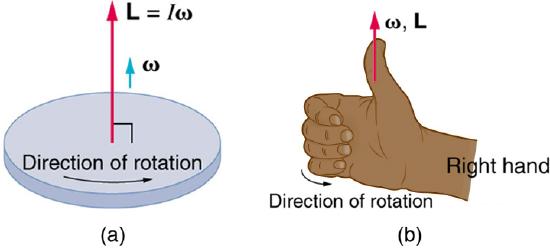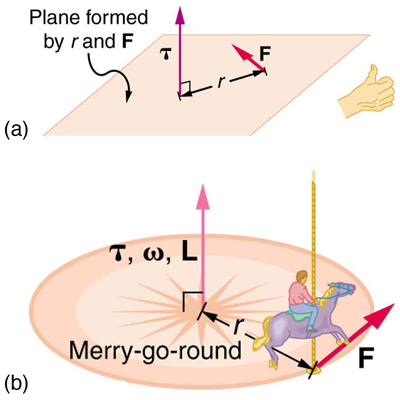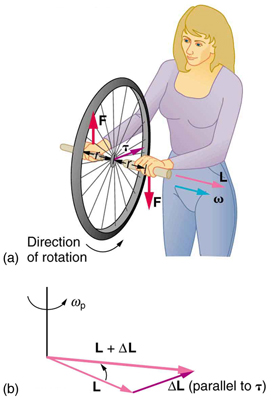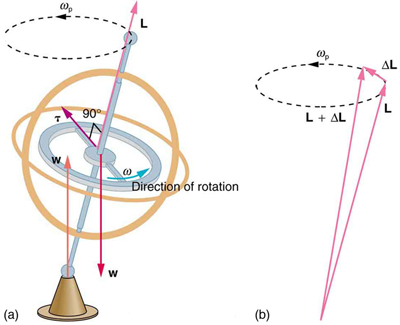6.6: Gyroscopic Effects- Vector Aspects of Angular Momentum
- Page ID
- 46906
Learning Objectives
- Describe the right-hand rule to find the direction of angular velocity, momentum, and torque.
- Explain the gyroscopic effect.
- Study how Earth acts like a gigantic gyroscope.
Angular momentum is a vector and, therefore, has direction as well as magnitude. Torque affects both the direction and the magnitude of angular momentum. What is the direction of the angular momentum of a rotating object like the disk in Figure \(\PageIndex{1}\)? The figure shows the right-hand rule used to find the direction of both angular momentum and angular velocity. Both \(\mathbf{L}\) and \(\boldsymbol{\omega}\) are vectors—each has direction and magnitude. Both can be represented by arrows. The right-hand rule defines both to be perpendicular to the plane of rotation in the direction shown. Because angular momentum is related to angular velocity by \(\mathbf{L}=I \boldsymbol{\omega}\), the direction of \(\mathbf{L}\) is the same as the direction of \(\boldsymbol{\omega}\). Notice in the figure that both point along the axis of rotation.

Now, recall that torque changes angular momentum as expressed by
\[\text { net } \boldsymbol{\tau}=\frac{\Delta \mathbf{L}}{\Delta t} \nonumber \]
This equation means that the direction of \(\Delta \mathbf{L}\) is the same as the direction of the torque \(\boldsymbol{\tau}\) that creates it. This result is illustrated in Figure \(\PageIndex{2}\), which shows the direction of torque and the angular momentum it creates.
Let us now consider a bicycle wheel with a couple of handles attached to it, as shown in Figure \(\PageIndex{3}\). (This device is popular in demonstrations among physicists, because it does unexpected things.) With the wheel rotating as shown, its angular momentum is to the woman's left. Suppose the person holding the wheel tries to rotate it as in the figure. Her natural expectation is that the wheel will rotate in the direction she pushes it—but what happens is quite different. The forces exerted create a torque that is horizontal toward the person, as shown in Figure \(\PageIndex{3}\)(a). This torque creates a change in angular momentum \(\mathbf{L}\) in the same direction, perpendicular to the original angular momentum \(\mathbf{L}\), thus changing the direction of \(\mathbf{L}\) but not the magnitude of \(\mathbf{L}\). Figure \(\PageIndex{3}\) shows how \(\Delta \mathbf{L}\) and \(\mathbf{L}\) add, giving a new angular momentum with direction that is inclined more toward the person than before. The axis of the wheel has thus moved perpendicular to the forces exerted on it, instead of in the expected direction.


This same logic explains the behavior of gyroscopes. Figure \(\PageIndex{4}\) shows the two forces acting on a spinning gyroscope. The torque produced is perpendicular to the angular momentum, thus the direction of the angular momentum is changed but not its magnitude, as a result of the change in angular momentum produced by the torque. This type of motion is called a precession, and we say that the gyroscope precesses around a vertical axis, since the torque is always horizontal and perpendicular to \(\mathbf{L}\). If the gyroscope is not spinning, it acquires initial angular momentum in the direction of the torque (\(\mathbf{L}=\Delta \mathbf{L}\)) and the change of angular momentum due to torque continues to add in the same direction, causing the gyroscope to rotate around a horizontal axis, falling over just as we would expect.
Earth itself acts like a gigantic gyroscope. Its angular momentum is along its axis and points at Polaris, the North Star. But Earth is slowly precessing (once in about 26,000 years) due to the torque of the Sun and the Moon on its nonspherical shape.

Exercise \(\PageIndex{1}\)
Rotational kinetic energy is associated with angular momentum? Does that mean that rotational kinetic energy is a vector?
- Answer
-
No, energy is always a scalar whether motion is involved or not. No form of energy has a direction in space and you can see that rotational kinetic energy does not depend on the direction of motion just as linear kinetic energy is independent of the direction of motion.
Section Summary
- Torque is perpendicular to the plane formed by \(r\) and \(\mathbf{F}\) and is the direction your right thumb would point if you curled the fingers of your right hand in the direction of \(\mathbf{F}\). The direction of the torque is thus the same as that of the change in angular momentum it produces.
- The gyroscope precesses around a vertical axis, since the torque is always horizontal and perpendicular to \(\mathbf{L}\). If the gyroscope is not spinning, it acquires angular momentum in the direction of the torque (\(\mathbf{L}=\Delta \mathbf{L}\)), and it rotates about a horizontal axis, falling over just as we would expect.
- Earth itself acts like a gigantic gyroscope. Its angular momentum is along its axis and points at Polaris, the North Star.
Glossary
- precession
- a type of motion that an object possessing angular momentum undergoes, as a torque perpendicular to the direction of angular momentum is applied, causing the direction of angular momentum to change; the circular wobbling motion traced by a slightly tilted circular top is an example
- right-hand rule
- direction of angular velocity \(\omega\) and angular momentum L in which the thumb of your right hand points when you curl your fingers in the direction of the disk’s rotation


